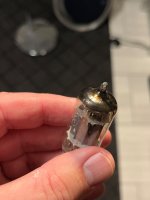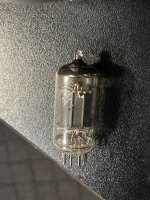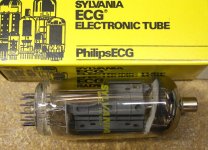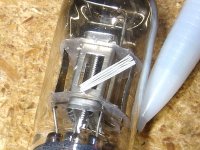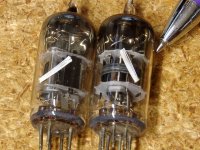Hi there. I recently bought a pair of 1958 Mullard tubes. One seemed to have slight defect in the top plate but I thought I’d try them in my phono stage. About 1 minute in BAM! It made a huge bang and fried my speaker.
Anyone ever have an exploding tube? You can see a chuck out of the top plate.
Anyone ever have an exploding tube? You can see a chuck out of the top plate.
Attachments
So how did this tube actually "explode" when it appears intact and still has a vacuum? There should not be anywhere near enough current flow in a phono stage to cause physical damage to a tube.
Just a defect causing an internal short. Not your problem, it's theirs.
Put a stop on your credit card, if it hasn't already cleared.
Or, many credit cards have their own warranty on purchases you make.
Put a stop on your credit card, if it hasn't already cleared.
Or, many credit cards have their own warranty on purchases you make.
That looks like a voice of music branded tube, and it looks very much like that was a manufacturing defect from the factory. You can see a bit of the Mica broken off at the top with looks like a metal support. Also loose in there. I’d be willing to bet that tube was like that since the day it was born.
Did it have that piece of metal in it before you plugged it in the socket? Like George said there’s no way there’s enough energy in a phono preamp to cause any kind of physical damage in a preamp tube. Can you be more specific about exactly what happened?
Did it have that piece of metal in it before you plugged it in the socket? Like George said there’s no way there’s enough energy in a phono preamp to cause any kind of physical damage in a preamp tube. Can you be more specific about exactly what happened?
I think it was George from tubelab who posted a few pictures of some tubes with random heaters hanging out inside the glass, mistakes do happen at tube factories, even Mullard 😱
Not great that your voice coil became the fuse; perhaps scope for a circuit improvement.
Can't remember all the f91 , f92, Blackburn, Mitcham factory identification codes. Looks like the print is worn so presume it was guess work with these based on the internal structure. Not cheap
Can't remember all the f91 , f92, Blackburn, Mitcham factory identification codes. Looks like the print is worn so presume it was guess work with these based on the internal structure. Not cheap
I bought a box full of new in box Sylvania 35LR6 tubes at the Dayton Hamfest in 2010. I have no information about their history, but most looked OK at first inspection. There was an obvious issue with one that was still in its original box which looked like it had never been opened. Note that some of the heater wires were hanging out of the bottom of the cathode, and the top mica was cocked sideways.I think it was George from tubelab who posted a few pictures of some tubes with random heaters hanging out inside the glass, mistakes do happen at tube factories, even Mullard 😱
Further inspection of all tubes revealed that the tabs that hold the top mica spacer to the plate had never been twisted or bent over. This leaves the mica free to pop right off of the plate. Note the perfectly straight tab at the top right corner of the plate. There were a few tubes with loose guts, but most worked well and stood up to ridiculous abuse like extracting over 250 watts from a single pair.
The weirdest discovery of all was finding a good working 6AG5 with an extra heater loosely left inside the glass. Even weirder......finding TWO of them.
Attachments
I did not know they made tubes with spare cathodes. Seems like it would come in handy when the existing cathode finally depletes. Joking aside I realize I would get distracted if I were stuffing tubes all day.
f91 has a wire up through the top mica to a staple which connects a thin wire to the cathode.
I dont know where the other end connects, or the purpose, yet I have a few samples and can take some good photos if helpful.
How could this 'fry your speaker' - or to ask, in what way is your speaker fried?
Likely a short (from where to where?) and now (from the pic) that short is no longer (looks very open!) - but be mindful of where the (now) loose conductor is within the tube.. that's important - can you see the dislodged conductor within the tube? (shake it). If not - test it, you might get lucky!
FWIW no other Mullard 'long plate' - I600, mc1 or f92 had this detail.
I dont know where the other end connects, or the purpose, yet I have a few samples and can take some good photos if helpful.
How could this 'fry your speaker' - or to ask, in what way is your speaker fried?
Likely a short (from where to where?) and now (from the pic) that short is no longer (looks very open!) - but be mindful of where the (now) loose conductor is within the tube.. that's important - can you see the dislodged conductor within the tube? (shake it). If not - test it, you might get lucky!
FWIW no other Mullard 'long plate' - I600, mc1 or f92 had this detail.
Last edited:
A tube failure in the preamp could cause a huge signal spike at the speaker output. It could kill it.How could this 'fry your speaker' - or to ask, in what way is your speaker fried?
I pulled a pair of Telefunken Smooth plates from my Zesto phono stage to try the "new" 1958 Mullards. The suspect tube didn't last more than a minute in the circuit and kablam! I guess I should have tested the tube first...but I've been rolling tubes for decades and usually the worst case is the tube is noisy or its weak to the point of failure.
The woofer coil is shot. I can barely move the cone. Thankfully everything else in the chain seems ok.
With regards to the tube....The fist generation Mullard is an MC1. Production on these stopped about 19567/7. These are super hard to find obviously...but they are incredible. The next generation is the Mullard F91 which was produced until about 1958/9. Its sonically very close. The F92 and beyond is good but I much prefer the predecessors.
My goal was to pair the Telefunkens...or Siemens long plates with the old mullards in my phono stage. Peanut butter and Jelly lol.
Now the problem is finding replacement drivers (Kef reference 201/2 woofer - sp1468). Its 6 inch 8 ohm. Only found 2 on the planet and one looks sketchy, and the other is in Germany and I need a European mobile number to register to the site. Doh!
The only woofer that seems to match the specs and plate/hole config is a Seas Excel 7 in woofer. Depending on the model...might be an upgrade?
The woofer coil is shot. I can barely move the cone. Thankfully everything else in the chain seems ok.
With regards to the tube....The fist generation Mullard is an MC1. Production on these stopped about 19567/7. These are super hard to find obviously...but they are incredible. The next generation is the Mullard F91 which was produced until about 1958/9. Its sonically very close. The F92 and beyond is good but I much prefer the predecessors.
My goal was to pair the Telefunkens...or Siemens long plates with the old mullards in my phono stage. Peanut butter and Jelly lol.
Now the problem is finding replacement drivers (Kef reference 201/2 woofer - sp1468). Its 6 inch 8 ohm. Only found 2 on the planet and one looks sketchy, and the other is in Germany and I need a European mobile number to register to the site. Doh!
The only woofer that seems to match the specs and plate/hole config is a Seas Excel 7 in woofer. Depending on the model...might be an upgrade?
Last edited:
Never heard about a 'F91' either.
What I found is it stands for the first version of the 'f9' Philips/Mullard tube type, which is a low microphony ECC83.
Now I need to check if I have some 😆
What I found is it stands for the first version of the 'f9' Philips/Mullard tube type, which is a low microphony ECC83.
Now I need to check if I have some 😆
- Home
- Amplifiers
- Tubes / Valves
- Exploding 1958 Mullard F91
